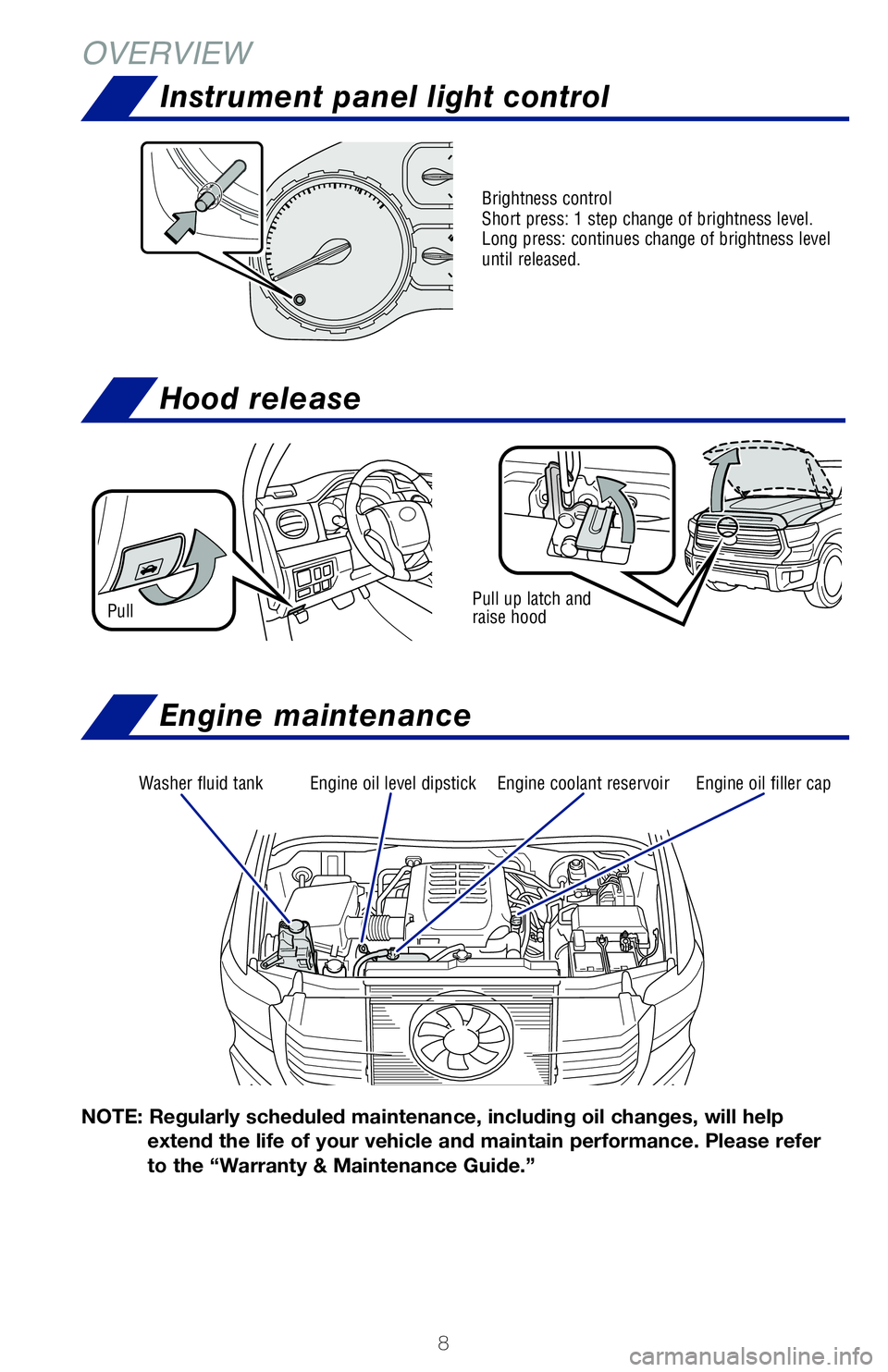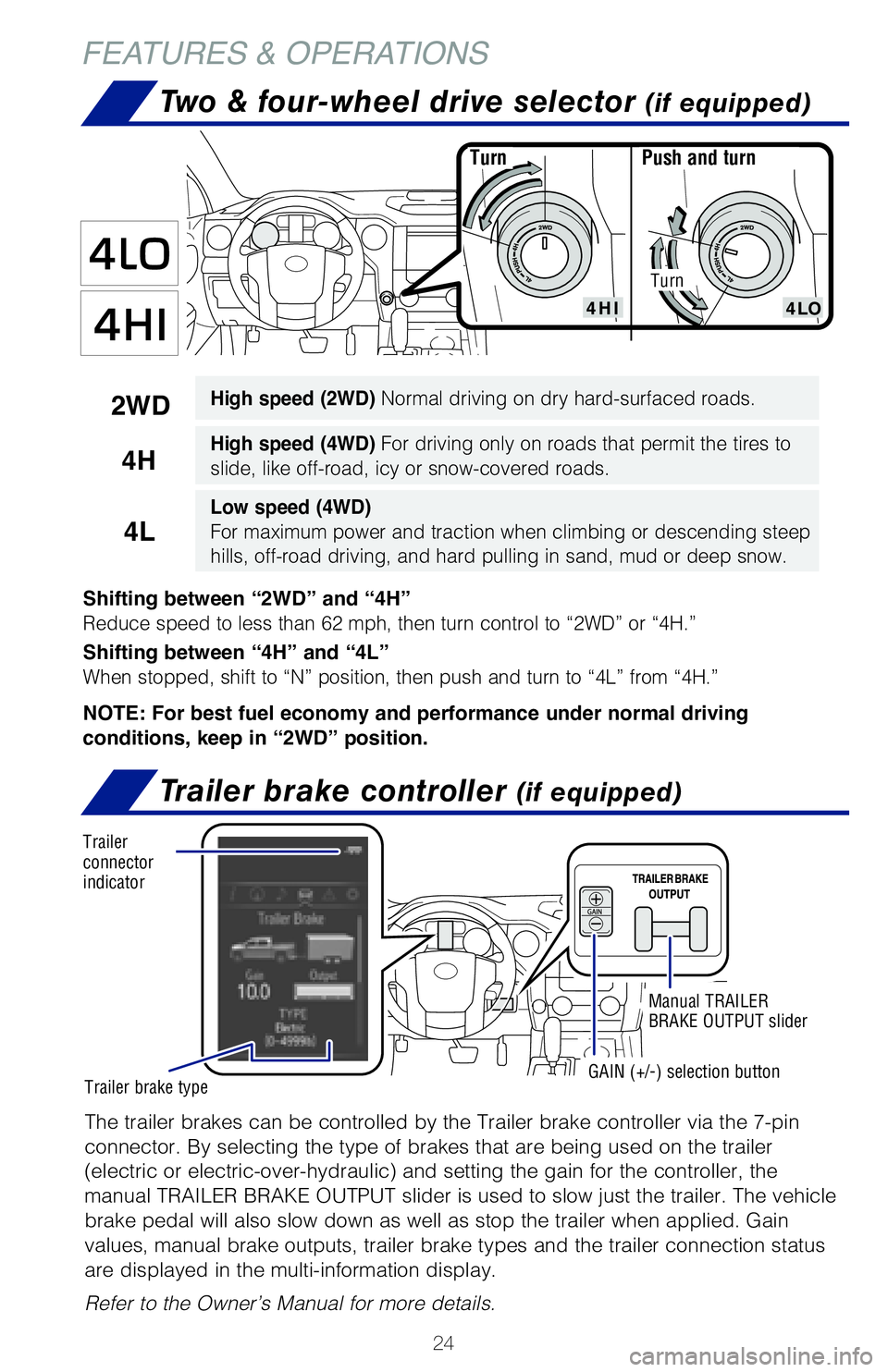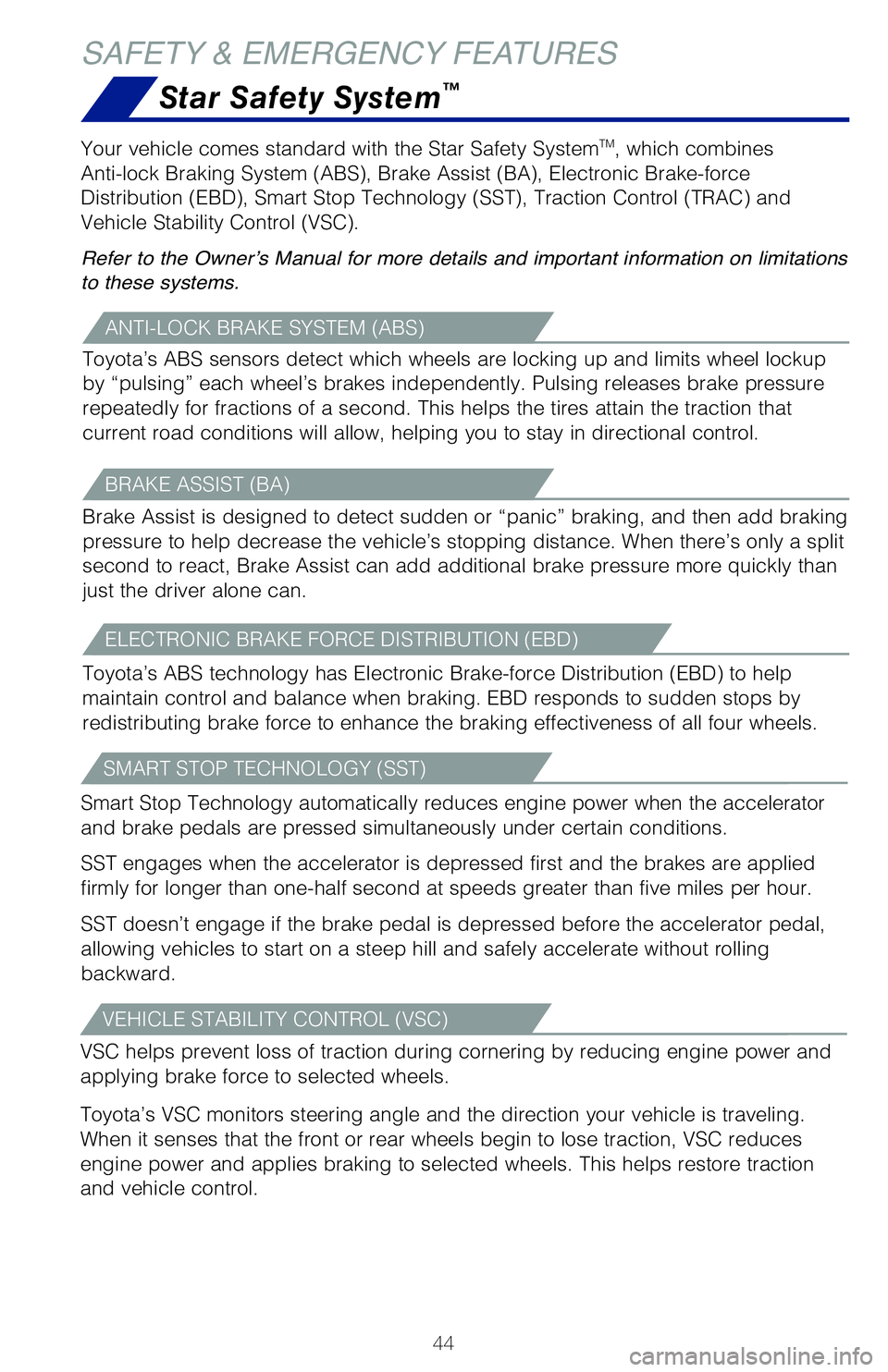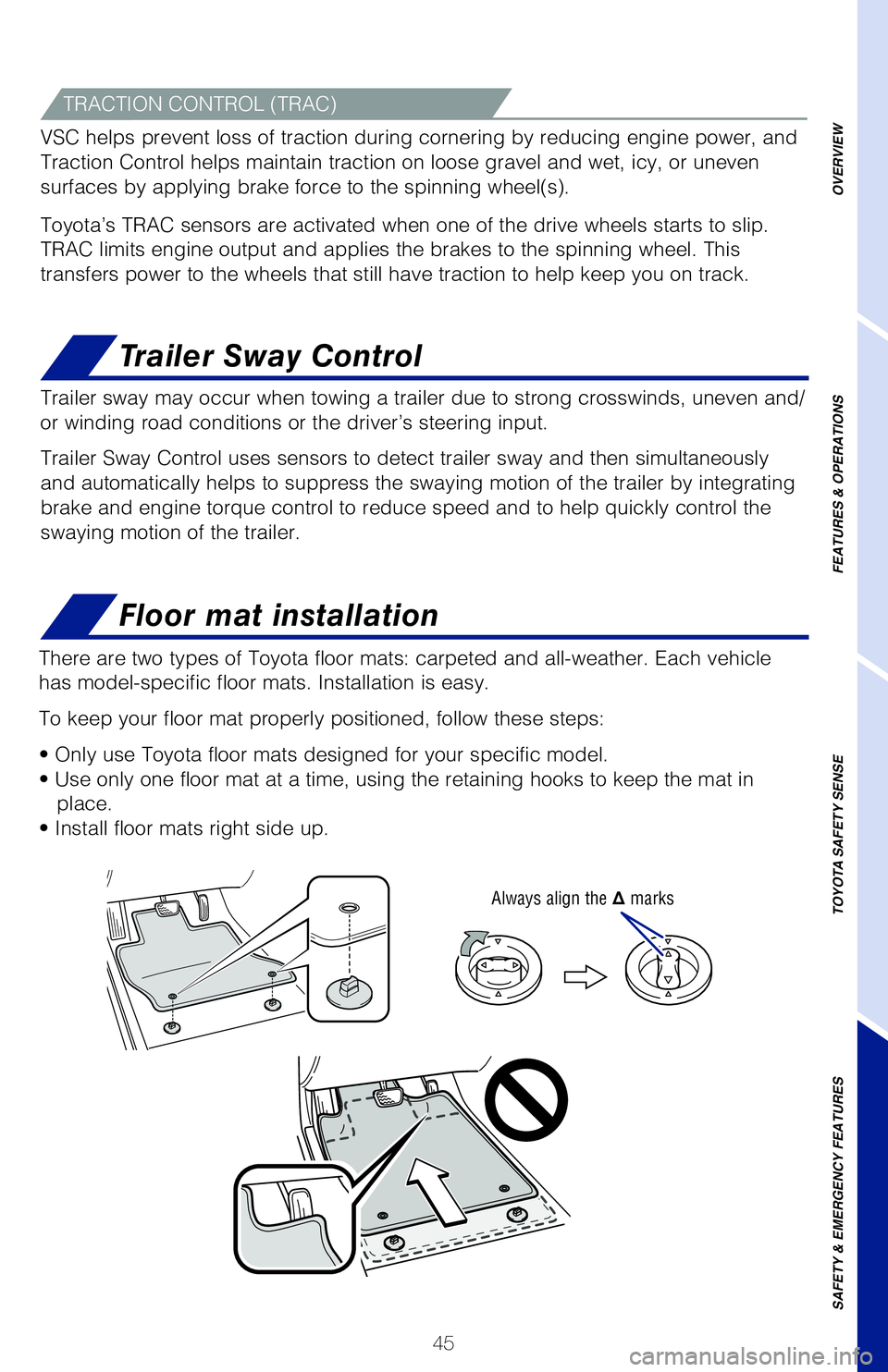towing TOYOTA TUNDRA 2021 Owners Manual (in English)
[x] Cancel search | Manufacturer: TOYOTA, Model Year: 2021, Model line: TUNDRA, Model: TOYOTA TUNDRA 2021Pages: 52, PDF Size: 3.8 MB
Page 10 of 52

8
OVERVIEWHood release
Pull up latch and
raise hoodPull
Washer fluid tankEngine coolant reservoirEngine oil filler capEngine oil level dipstick
NOTE: Regularly scheduled maintenance, including oil changes, will help \
extend the life of your vehicle and maintain performance. Please refer
to the “Warranty & Maintenance Guide.”
Engine maintenance
Brightness control
Short press: 1 step change of brightness level.
Long press: continues change of brightness level
until released.
Instrument panel light control
FEATURES & OPERATIONS
Mirrors can be manually slid outward to improve visibility while towing.\
Key must be in the “ACC” or “ON” position.
Refer to the Owner’s Manual for more details.
Type A
Type A Folding from inside (if equipped)
Type B
Automatic door locks can be programmed to operate in different modes, or\
turned
OFF.
Shift position linked door locking function
-Doors lock when shifting from Park.
�'river’s door linked door unlocking function
-Doors unlock within 10 seconds after the vehicle is turned off and driv\
er’s door is opened.
Refer to the Owner’s Manual for more details.
Shift position and speed linked door unlocking/locking function
-Doors unlock when shifting into Park.
-Doors lock when the vehicle speed goes above approximately 12 mph (20 \
km/h).
ADJUST AND FOLD
EXTEND (IF EQUIPPED)
DEFAULT SETTING
CUSTOMIZED SETTING
MY21_Tundra_QRG_V2_ML_0709.indd 87/13/20 10:54 AM
Page 11 of 52

9
OVERVIEW
FEATURES & OPERATIONS
TOYOTA SAFETY SENSE
SAFETY & EMERGENCY FEATURES
Engine oil filler cap
NOTE: Regularly scheduled maintenance, including oil changes, will help \
extend the life of your vehicle and maintain performance. Please refer
to the “Warranty & Maintenance Guide.”
Engine maintenance
Brightness control
Short press: 1 step change of brightness level.
Long press: continues change of brightness level
until released.
FEATURES & OPERATIONS
Mirrors-Power outside rear view (if equipped)
Mirrors can be manually slid outward to improve visibility while towing.\
Adjust up,
down, left
and right Select left
or right
Key must be in the “ACC” or “ON” position.
Refer to the Owner’s Manual for more details.
Type A Type B
Type A Folding from inside (if equipped) Adjusting mirrors
Type B
Automatic door locks can be programmed to operate in different modes, or\
turned
OFF.
Shift position linked door locking function
-Doors lock when shifting from Park.
�'river’s door linked door unlocking function
-Doors unlock within 10 seconds after the vehicle is turned off and driv\
er’s door is opened.
Refer to the Owner’s Manual for more details.
Shift position and speed linked door unlocking/locking function
-Doors unlock when shifting into Park.
-Doors lock when the vehicle speed goes above approximately 12 mph (20 \
km/h).
ADJUST AND FOLD
EXTEND (IF EQUIPPED)
Auto lock/unlock
DEFAULT SETTING
CUSTOMIZED SETTING
MY21_Tundra_QRG_V2_ML_0709.indd 97/13/20 10:54 AM
Page 26 of 52

24
FEATURES & OPERATIONS
Push and turnTurn
Shifting between “2WD” and “4H”
Reduce speed to less than 62 mph, then turn control to “2WD” or “\
4H.”
Shifting between “4H” and “4L”
When stopped, shift to “N” position, then push and turn to “4L”\
from “4H.”
NOTE: For best fuel economy and performance under normal driving
conditions, keep in “2WD” position.
2WDHigh speed (2WD) Normal driving on dry hard-surfaced roads.
4HHigh speed (4WD) For driving only on roads that permit the tires to
slide, like off-road, icy or snow-covered roads.
4L
Low speed (4WD)
For maximum power and traction when climbing or descending steep
hills, off-road driving, and hard pulling in sand, mud or deep snow.
Turn
Two & four-wheel drive selector (if equipped)
The trailer brakes can be controlled by the Trailer brake controller via\
the 7-pin
connector. By selecting the type of brakes that are being used on the tr\
ailer
(electric or electric-over-hydraulic) and setting the gain for the con\
troller, the
manual TRAILER BRAKE OUTPUT slider is used to slow just the trailer. The\
vehicle
brake pedal will also slow down as well as stop the trailer when applied\
. Gain
values, manual brake outputs, trailer brake types and the trailer connec\
tion status
are displayed in the multi-information display.
Refer to the Owner’s Manual for more details.
“Tow/Haul” mode is ideal for use when carrying heavy loads. When t\
he TOW/HAUL
switch is pressed, throttle response and transmission control are optimi\
zed for the
high performance operation. As fuel economy is reduced while in “Tow/\
Haul” mode,
deactivating when driving without a load is recommended.
• Upshifts occur at higher engine speeds to expand the use of lower g\
ear ranges, enhancing power performance during towing and preventing repeated gear
changes.
• Downshifts occur at a greater accelerator pedal angle to allow the vehic\
le to stay
in a higher gear, reducing repeated gear changes.
• Downshifts occur at a lower accelerator pedal angle to allow the vehicle\
to stay in
a lower gear, enhancing towing ability.
• When the accelerator pedal is wide open, upshift timing is optimized to \
effectively
use the maximum engine power range available.
When Tow/Haul is engaged, the opening angle of the electronically contro\
lled
throttle is wider for any given accelerator pedal position than normal, \
enhancing
acceleration feeling and response.
• During uphill driving, the gear position is held to prevent repeated ups\
hifting.
• During downhill driving, downshifting to lower gears will occur to effec\
tively use
engine braking.
Refer to the Owner’s Manual for more details on this system before at\
tempting to
use it.
Floor shift type
Trailer brake controller (if equipped)
ENGINE CONTROL
ENHANCED SHIFT CONTROL
UPHILL/DOWNHILL SHIFT FEATURES
Manual TRAILER
BRAKE OUTPUT slider
Trailer
connector
indicator
Trailer brake type
GAIN (+/-) selection button
MY21_Tundra_QRG_V2_ML_0709.indd 247/13/20 10:54 AM
Page 27 of 52

25
Shifting between “2WD” and “4H”
Reduce speed to less than 62 mph, then turn control to “2WD” or “\
4H.”
Shifting between “4H” and “4L”
When stopped, shift to “N” position, then push and turn to “4L”\
from “4H.”
NOTE: For best fuel economy and performance under normal driving
conditions, keep in “2WD” position.
High speed (2WD) Normal driving on dry hard-surfaced roads.
High speed (4WD) For driving only on roads that permit the tires to
slide, like off-road, icy or snow-covered roads.
Low speed (4WD)
For maximum power and traction when climbing or descending steep
hills, off-road driving, and hard pulling in sand, mud or deep snow.
Two & four-wheel drive selector (if equipped)
The trailer brakes can be controlled by the Trailer brake controller via\
the 7-pin
connector. By selecting the type of brakes that are being used on the tr\
ailer
(electric or electric-over-hydraulic) and setting the gain for the con\
troller, the
manual TRAILER BRAKE OUTPUT slider is used to slow just the trailer. The\
vehicle
brake pedal will also slow down as well as stop the trailer when applied\
. Gain
values, manual brake outputs, trailer brake types and the trailer connec\
tion status
are displayed in the multi-information display.
Refer to the Owner’s Manual for more details.
TOW/HAUL switch (if equipped)
“Tow/Haul” mode is ideal for use when carrying heavy loads. When t\
he TOW/HAUL
switch is pressed, throttle response and transmission control are optimi\
zed for the
high performance operation. As fuel economy is reduced while in “Tow/\
Haul” mode,
deactivating when driving without a load is recommended.
• Upshifts occur at higher engine speeds to expand the use of lower g\
ear ranges, enhancing power performance during towing and preventing repeated gear
changes.
• Downshifts occur at a greater accelerator pedal angle to allow the vehic\
le to stay
in a higher gear, reducing repeated gear changes.
• Downshifts occur at a lower accelerator pedal angle to allow the vehicle\
to stay in
a lower gear, enhancing towing ability.
• When the accelerator pedal is wide open, upshift timing is optimized to \
effectively
use the maximum engine power range available.
When Tow/Haul is engaged, the opening angle of the electronically contro\
lled
throttle is wider for any given accelerator pedal position than normal, \
enhancing
acceleration feeling and response.
•
During uphill driving, the gear position is held to prevent repeated ups\
hifting.
• During downhill driving, downshifting to lower gears will occur to effec\
tively use
engine braking.
Refer to the Owner’s Manual for more details on this system before at\
tempting to
use it.
Floor shift type
System ON/OFF
System ON/OFF
Column shift type
ENGINE CONTROL
ENHANCED SHIFT CONTROL
UPHILL/DOWNHILL SHIFT FEATURES
OVERVIEW
FEATURES & OPERATIONS
TOYOTA SAFETY SENSE
SAFETY & EMERGENCY FEATURES
Manual TRAILER
BRAKE OUTPUT slider
MY21_Tundra_QRG_V2_ML_0709.indd 257/13/20 10:54 AM
Page 46 of 52

44
There are two types of Toyota floor mats: carpeted and all-weather. Each\
vehicle
has model-specific floor mats. Installation is easy.
To keep your floor mat properly positioned, follow these steps:
• Only use Toyota floor mats designed for your specific model.
• Use only one floor mat at a time, using the retaining hooks to keep\
the mat in place.
• Install floor mats right side up. Trailer sway may occur when towing a trailer due to strong crosswinds, u\
neven and/
or winding road conditions or the driver’s steering input.
Trailer Sway Control uses sensors to detect trailer sway and then simult\
aneously
and automatically helps to suppress the swaying motion of the trailer by\
integrating
brake and engine torque control to reduce speed and to help quickly cont\
rol the
swaying motion of the trailer.
TRACTION CONTROL (TRAC)
VSC helps prevent loss of traction during cornering by reducing engine p\
ower, and
Traction Control helps maintain traction on loose gravel and wet, icy, o\
r uneven
surfaces by applying brake force to the spinning wheel(s).
Toyota’s TRAC sensors are activated when one of the drive wheels star\
ts to slip.
TRAC limits engine output and applies the brakes to the spinning wheel. \
This
transfers power to the wheels that still have traction to help keep you \
on track.
SAFETY & EMERGENCY FEATURES
Star Safety System
™
ANTI-LOCK BRAKE SYSTEM (ABS)
Toyota’s ABS sensors detect which wheels are locking up and limits wh\
eel lockup
by “pulsing” each wheel’s brakes independently. Pulsing release\
s brake pressure
repeatedly for fractions of a second. This helps the tires attain the tr\
action that
current road conditions will allow, helping you to stay in directional c\
ontrol.
BRAKE ASSIST (BA)
Brake Assist is designed to detect sudden or “panic” braking, and \
then add braking
pressure to help decrease the vehicle’s stopping distance. When there\
’s only a split
second to react, Brake Assist can add additional brake pressure more qui\
ckly than
just the driver alone can.
ELECTRONIC BRAKE FORCE DISTRIBUTION (EBD)
Toyota’s ABS technology has Electronic Brake-force Distribution (EBD\
) to help
maintain control and balance when braking. EBD responds to sudden stops \
by
redistributing brake force to enhance the braking effectiveness of all f\
our wheels.
Your vehicle comes standard with the Star Safety System
TM, which combines
Anti-lock Braking System (ABS), Brake Assist (BA), Electronic Brake-\
force
Distribution (EBD), Smart Stop Technology (SST), Traction Control (\
TRAC) and
Vehicle Stability Control (VSC).
Refer to the Owner’s Manual for more details and important information on limitations
to these systems.
SMART STOP TECHNOLOGY (SST)
Smart Stop Technology automatically reduces engine power when the accele\
rator
and brake pedals are pressed simultaneously under certain conditions.
SST engages when the accelerator is depressed first and the brakes are a\
pplied
firmly for longer than one-half second at speeds greater than five miles\
per hour.
SST doesn’t engage if the brake pedal is depressed before the acceler\
ator pedal,
allowing vehicles to start on a steep hill and safely accelerate without\
rolling
backward.
VEHICLE STABILITY CONTROL (VSC)
VSC helps prevent loss of traction during cornering by reducing engine p\
ower and
applying brake force to selected wheels.
Toyota’s VSC monitors steering angle and the direction your vehicle i\
s traveling.
When it senses that the front or rear wheels begin to lose traction, VSC\
reduces
engine power and applies braking to selected wheels. This helps restore \
traction
and vehicle control.
MY21_Tundra_QRG_V2_ML_0709.indd 447/13/20 10:54 AM
Page 47 of 52

45
Floor mat installation
Trailer Sway Control
There are two types of Toyota floor mats: carpeted and all-weather. Each\
vehicle
has model-specific floor mats. Installation is easy.
To keep your floor mat properly positioned, follow these steps:
• Only use Toyota floor mats designed for your specific model.
• Use only one floor mat at a time, using the retaining hooks to keep\
the mat in place.
• Install floor mats right side up.
Always align the marks
Trailer sway may occur when towing a trailer due to strong crosswinds, u\
neven and/
or winding road conditions or the driver’s steering input.
Trailer Sway Control uses sensors to detect trailer sway and then simult\
aneously
and automatically helps to suppress the swaying motion of the trailer by\
integrating
brake and engine torque control to reduce speed and to help quickly cont\
rol the
swaying motion of the trailer.
TRACTION CONTROL (TRAC)
VSC helps prevent loss of traction during cornering by reducing engine p\
ower, and
Traction Control helps maintain traction on loose gravel and wet, icy, o\
r uneven
surfaces by applying brake force to the spinning wheel(s).
Toyota’s TRAC sensors are activated when one of the drive wheels star\
ts to slip.
TRAC limits engine output and applies the brakes to the spinning wheel. \
This
transfers power to the wheels that still have traction to help keep you \
on track.
OVERVIEW
FEATURES & OPERATIONS
TOYOTA SAFETY SENSE
SAFETY & EMERGENCY FEATURES
Star Safety System™
Toyota’s ABS sensors detect which wheels are locking up and limits wh\
eel lockup
by “pulsing” each wheel’s brakes independently. Pulsing release\
s brake pressure
repeatedly for fractions of a second. This helps the tires attain the tr\
action that
current road conditions will allow, helping you to stay in directional c\
ontrol.
Brake Assist is designed to detect sudden or “panic” braking, and \
then add braking
pressure to help decrease the vehicle’s stopping distance. When there\
’s only a split
second to react, Brake Assist can add additional brake pressure more qui\
ckly than
just the driver alone can.
Toyota’s ABS technology has Electronic Brake-force Distribution (EBD\
) to help
maintain control and balance when braking. EBD responds to sudden stops \
by
redistributing brake force to enhance the braking effectiveness of all f\
our wheels.
Your vehicle comes standard with the Star Safety System
TM, which combines
Anti-lock Braking System (ABS), Brake Assist (BA), Electronic Brake-\
force
Distribution (EBD), Smart Stop Technology (SST), Traction Control (\
TRAC) and
Vehicle Stability Control (VSC).
Refer to the Owner’s Manual for more details and important information on limitations
to these systems.
Smart Stop Technology automatically reduces engine power when the accele\
rator
and brake pedals are pressed simultaneously under certain conditions.
SST engages when the accelerator is depressed first and the brakes are a\
pplied
firmly for longer than one-half second at speeds greater than five miles\
per hour.
SST doesn’t engage if the brake pedal is depressed before the acceler\
ator pedal,
allowing vehicles to start on a steep hill and safely accelerate without\
rolling
backward.
VSC helps prevent loss of traction during cornering by reducing engine p\
ower and
applying brake force to selected wheels.
Toyota’s VSC monitors steering angle and the direction your vehicle i\
s traveling.
When it senses that the front or rear wheels begin to lose traction, VSC\
reduces
engine power and applies braking to selected wheels. This helps restore \
traction
and vehicle control.
MY21_Tundra_QRG_V2_ML_0709.indd 457/13/20 10:54 AM